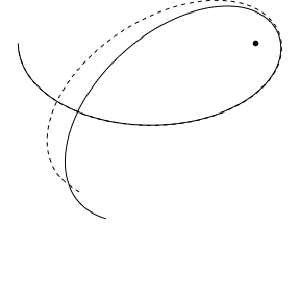Post
Frame Dragging
14 March 2012
I’ve been writing a bit on frame dragging for the book. Frame dragging is another one of these interesting effects that shows up in general relativity. Since gravity is an effect of curved space and time in GR, you get things like wibbly-wobbly spacey-timey gravitational waves. This also means that when you rotate a mass, the space and time around it is twisted a bit. In other words, the space and time around a rotating black hole is not only bent due to the black hole’s mass, it is also twisted due to the black hole’s rotation.
 Brian Koberlein
Brian KoberleinSo how would this affect the motion of stars around the massive black hole in our galaxy’s core? I’ve plotted the result in the figure here. The solid line represents the path of a close orbiting star if the black hole isn’t rotating. The dotted line represents the star’s path if the black hole is rotating rapidly (75% of its maximum limit). They start off nearly identical, but in the rotating case the star’s orbit doesn’t precess nearly as much. This is because the twisted nature of space around the rotating black hole gives the star a bit of angular momentum (slowing down the black hole just a bit in the process) which shifts its orbit just a bit.
The figure I’ve drawn is an exaggerated case. Even if the supermassive black hole in our galaxy is rotating near its maximum, we wouldn’t see the nearby stars affected by such a large amount. But if we keep watching those stars in the core, we might be able to determine the black hole’s rotation eventually.
What we do know is that frame dragging is a real effect. It’s been observed by a satellite orbiting Earth known as Gravity Probe B. Once again Einstein’s theory holds true.